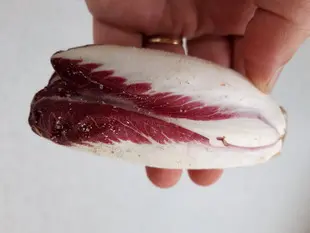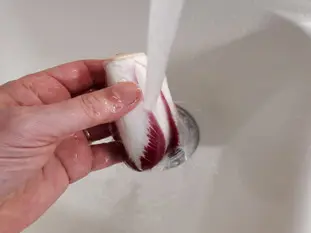This site uses only a few technical cookies necessary for its operation. By continuing to browse, you accept their use.
To find out more...
To find out more...
Cleaning endives

If you buy your endives elsewhere than in supermarkets, and in this case the best is of course from a market gardener, he or she is the one who planted and harvested them, in this case you will have endives full of earth or sand, depending on where they were grown, which is normal and reassuring, we know where they come from.
How to wash/clean them efficiently? That's what we'll see in this post.
How to wash/clean them efficiently? That's what we'll see in this post.
26 K 4.6/5 (18 reviews)
Keywords for this post:EndivesCleaningSoilSandAdviceLast modified on: March 24th 2020
Cleaning endives
When it comes to cleaning, the classic way is to cut the base, then remove the leaves from around the endive, until you have a very clean vegetable. Classic, but not great, the loss is important, especially if the endive comes from the sand, you have to remove a lot of leaves (too many), to have one ready to be used in a recipe.
Can we do better?
Yes, it is better to wash it in fact, before trimming it, but this washing should not be done like for another vegetable, by soaking them in water for example. On the contrary, on the one hand they get waterlogged if you do that, but on the other hand a small part of the sand that was on the turn will end up in the endive, and when tasted it will crunch under the tooth very unpleasantly.
No, here's the thing, in fact it's better to proceed like this: Run a trickle of warm water from the tap, and put the endive underneath one by one, with the head down, like this:
This way, the sand goes into the sink, the endive does not get waterlogged, and the peeling after drying with a cloth, will consist in removing 1 or 2 leaves from the turn, not more, or even none.
You will note that on the photographs they are red endives, with the season alas even shorter, but which are less bitter than the yellow ones, and of a superb esthetics which make it possible, inter alia, to make a little of decoration in your receipts/plates at little expenses.
One last point about the plastic endive from the supermarket, you have probably noticed that they are absolutely clean, not a grain of sand or dirt. Is it normal knowing that it comes from the earth or sand? To look like this on the shelves, you have to imagine that they must have received a shock treatment, probably not neutral, which have scoured them, or even more. In short, trust your local grower who plants locally.
To sum up: Wash your endives under a trickle of warm water, upside down, before drying them and trimming them.
Can we do better?
Yes, it is better to wash it in fact, before trimming it, but this washing should not be done like for another vegetable, by soaking them in water for example. On the contrary, on the one hand they get waterlogged if you do that, but on the other hand a small part of the sand that was on the turn will end up in the endive, and when tasted it will crunch under the tooth very unpleasantly.
No, here's the thing, in fact it's better to proceed like this: Run a trickle of warm water from the tap, and put the endive underneath one by one, with the head down, like this:

This way, the sand goes into the sink, the endive does not get waterlogged, and the peeling after drying with a cloth, will consist in removing 1 or 2 leaves from the turn, not more, or even none.
You will note that on the photographs they are red endives, with the season alas even shorter, but which are less bitter than the yellow ones, and of a superb esthetics which make it possible, inter alia, to make a little of decoration in your receipts/plates at little expenses.
One last point about the plastic endive from the supermarket, you have probably noticed that they are absolutely clean, not a grain of sand or dirt. Is it normal knowing that it comes from the earth or sand? To look like this on the shelves, you have to imagine that they must have received a shock treatment, probably not neutral, which have scoured them, or even more. In short, trust your local grower who plants locally.
To sum up: Wash your endives under a trickle of warm water, upside down, before drying them and trimming them.
Lasts posts
Butter vs. grease
We often read in a recipe where a pastry is put into a mould that, just before pouring, the mould should be buttered or greased. But what's the difference between these 2 terms?December 1st 20251,0745
Getting out of the fridge early
Very often when you're cooking, you need to take food or preparations out of the fridge, to use them in the recipe in progress. There's nothing tricky about this: you just take them out of the fridge and use them, usually immediately, in the recipe. But is this really a good method?November 24th 20251,1635
Who's making the croissants?
When you look at a bakery from the outside, you naturally think that in the bakery, the bakers make the bread, and in the laboratory, the pastry chefs make the cakes. It's very often like that, with each of these professions having quite different ways of working, but sometimes there's also one...November 23th 20251,058
Oven height
When we put a dish or cake in the oven, we naturally tend to put it on the middle shelf, and that's what we usually do. But in some cases, this position and height can be a little tricky, so let's find out why.October 8th 20252,8595
The importance of sieving
In recipes that use a fine powder (flour, powdered sugar, etc.), you'll often see the advice to sift before using it. To sift is to pass the powder in question through a sieve (a very fine strainer) before incorporating it into your recipe. It's often advice, but is it really useful?September 3rd 20257,5973
Other pages you may also like
The bitterness of endives
As I write these lines, we are entering the endive season, and if you like it, it's time to enjoy it, if possible with your local producers. Endive is good, but the reproach that is often made of it, and children in particular, is: "It's bitter! And it is (somewhat) true of course, endives...February 9th 201914 K4.9
The so-called "nervous" meats
You've probably heard this before, we're talking about "nervous" meat, or meat with nerves, to describe what is indicated by the blue arrow on the left. This is a piece of beef, and what we call a nerve is not a nerve, it is in fact collagen (chemists sometimes call it a "collagen sink"), a...April 16th 202137 K4.5
Fruits which can ruin your jelly
There are many ways of making a fruit mousse, but one of the simplest is to prepare a fruit jelly (basically a fresh fruit coulis with gelatine) and then mix this jelly before it sets completely with whipped cream. The result is perfect for filling a charlotte, for example. But do beware;...March 6th 201378 K4.0
What is the difference between bakery and patisserie?
This is a question that you may well have asked yourself and which I will attempt to answer. In France the two trades of "boulangerie" (bakery) and "pâtisserie" (patisserie and confectionery) have always been quite distinct, but where exactly do the boundaries lie? .February 7th 2017134 K 14.1
Candied fruits: don't get ripped off
Do you like candied fruit? You might like to nibble a handful or add it to a recipe, like a classic fruit cake or delicious Italian specialities like panettone or sicilian epiphany pie.June 21th 201767 K 24.2
Post a comment or question
Follow this page
If you are interested in this page, you can "follow" it, by entering your email address here. You will then receive a notification immediately each time the page is modified or a new comment is added. Please note that you will need to confirm this following.
Note: We'll never share your e-mail address with anyone else.
Alternatively: you can subscribe to the mailing list of cooling-ez.com , you will receive a e-mail for each new recipe published on the site.









